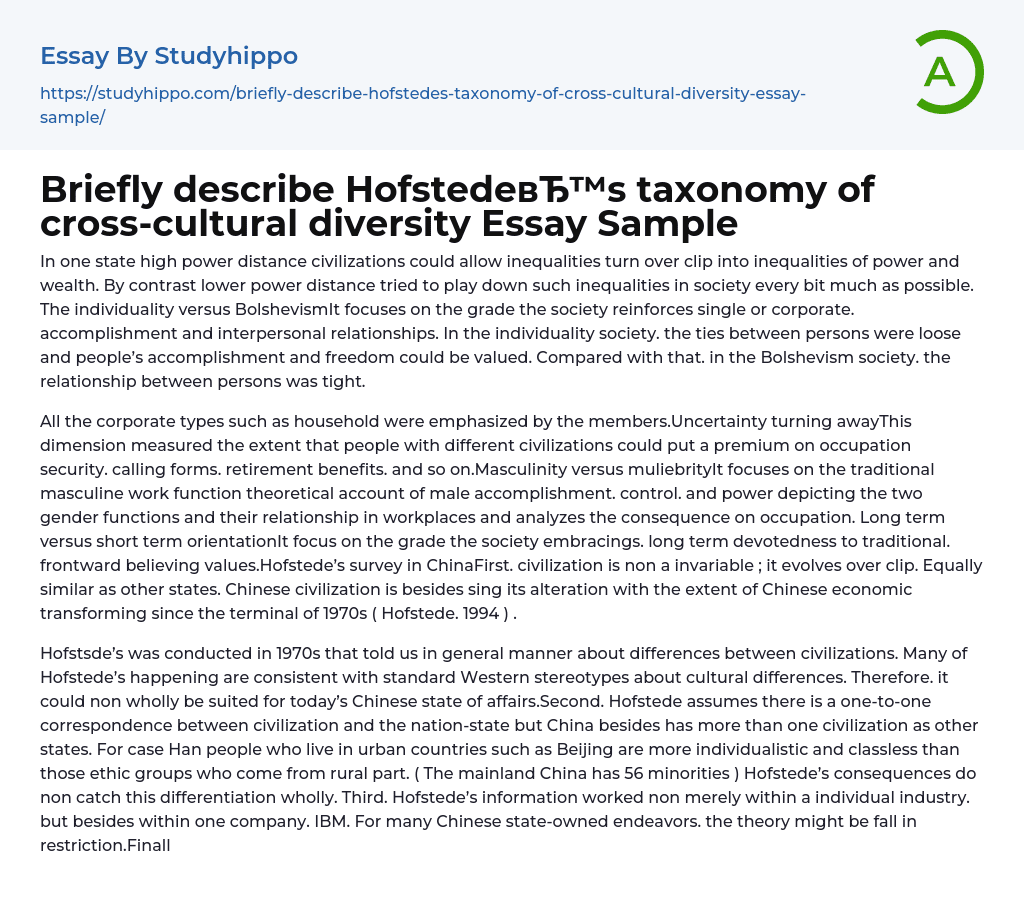

Briefly describe Hofstede’s taxonomy of cross-cultural diversity Essay Sample
High power distance societies may experience a transformation of inequalities into both power and wealth disparities over time. Conversely, low power distance societies strive to minimize these societal inequalities.
The text examines the contrast between individuality and Bolshevism, emphasizing how society promotes either personal or collective success and relationships. In a society promoting individuality, interpersonal connections were less restrictive and individuals could prioritize personal achievement and freedom. In comparison to that viewpoint,
Within the Bolshevism society, there existed a strong bond between individuals emphasizing the importance of various social structures, including households. The degree to which people from different cultures valued job security, employment contracts, retirement benefits, etc. was measured by the dimension known as uncertainty avoidance. Another dimension, masculinity versus femininity, concentrated on the traditional male role in the workforce and their achievements.
Control
...and power illustrate the roles of both genders in workplaces and explores their impact on occupations. It also examines the consequences of long-term versus short-term orientation, focusing on societal attitudes towards traditional values and forward-thinking. Hofstede conducted a study in China, recognizing that culture is not static but evolves over time.
The Chinese civilization is undergoing changes in line with the transformation of the Chinese economy since the 1970s (Hofstede, 1994). Hofstede's study, conducted in the 1970s, provided a general understanding of cultural differences.
Many of Hofstede’s findings align with typical Western stereotypes concerning cultural differences, which may not fully apply to China's present situation. Furthermore, Hofstede overlooks the fact that China, like other nations, encompasses multiple cultures and assumes a direct correlation between culture and the nation-state.
According to Hofstede's research, there is a difference between urban Han people residing in cities such as Beijin
and rural ethnic groups regarding individualism and classlessness. It is crucial to acknowledge that Hofstede's findings do not entirely encompass this distinction. Furthermore, his data is not exclusive to any particular industry.
However, this theory might not apply to all Chinese state-owned enterprises, as they may face different limitations. Ultimately, this classification of cross-cultural diversity has been widely accepted to help individuals address cultural conflicts and reduce expenses.
- Feminism essays
- Animal Rights essays
- Animal Testing essays
- Bullying essays
- Abortion essays
- Abuse essays
- Immigration essays
- Poverty essays
- Human Rights essays
- Inequality essays
- Violence essays
- Torture essays
- Crash essays
- Assault essays
- Racism essays
- Prejudice essays
- Controversial Issue essays
- Cyber Bullying essays
- Women's Suffrage essays
- Women'S Rights essays
- Women Empowerment essays
- Sojourner Truth essays
- Bullying In Schools essays
- Pro Choice essays
- Pro Life essays
- Should Abortion Be Legal essays
- Against abortion essays
- Abortion Debate essays
- Abuse Support essays
- Child Abuse essays
- Alcohol Abuse essays
- Physical Abuse essays
- Sexual Abuse essays
- Substance Abuse essays
- Migration essays
- Human Migration essays
- Illegal Immigration essays
- Immigrants essays
- Refugee essays
- Overpopulation essays
- Homelessness essays
- Hunger essays
- Dumpster Diving essays
- Homelessness In America essays
- Euthanasia essays
- Assisted Suicide essays
- Censorship essays
- Gun Control essays
- Empowerment essays
- Civil Rights essays



